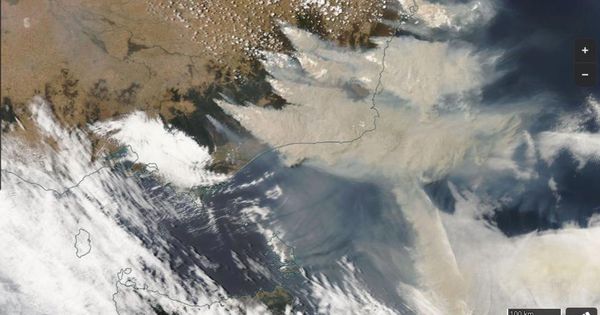
NASA’s Worldview – A Useful Public Tool For Monitoring Australian Fires (And More)
Most reasonable people are stunned by the ongoing fires in Australia. An infographic by Statista.com grabbed my attention this morning. It provided a comparison of acres burned by recent headline-grabbing wildfires.
The devastating California wildfires of 2018 and last year’s fires in the Amazon rainforest made international headlines and shocked the world, but in terms of size they are far smaller than the current bushfire crisis in Australia, where approximately 12 million acres have been burned to date. Fires in remote parts of northern Russia burned 6.7 million acres last year, but most of the regions were sparsely populated and no casualties were reported.
Australia is only in the middle of its fire season according to Bucholz so I would not expect them to end anytime soon. There are many perspectives from which the fires have been written about: climate change, caramelized snow on glaciers, and so forth. Herein, I wanted to introduce you to a resource that I use for monitoring such events, NASA Worldview.

Smoke plumes from Fires in Australia in early January 2020. True color reflectance.
NASA
The image above was generated on the NASA Worldview website and shows true color reflectance on January 4th, 2020. Plumes of smoke associated with fires are evident. In fact, many of these fires are actually creating Pyrocumulonimbus clouds, which are thunderstorms generated by the intense heat and aerosols associated with the fires themselves (graphic below).
What is this NASA Worldview tool? According to the NASA Precipitation Measurement Missions (PMM) website:
This tool from NASA’s Earth Observing System Data and Information System (EOSDIS) provides the capability to interactively browse global, full-resolution satellite imagery and then download the underlying data….Many of the 600+ available products are updated within three hours of observation, essentially showing the entire Earth as it looks “right now”. This supports time-critical application areas such as wildfire management, air quality measurements, and flood monitoring. Arctic and Antarctic views of several products are also available for a “full globe” perspective. Browsing on tablet and smartphone devices is generally supported for mobile access to the imagery.

Pyrocumulonimbus clouds are being generated by many of the Australian fires.
Australian Bureau of Meteorology
I teach a 1-hour freshman seminar called “Observing the Earth From Space” at the University of Georgia. One of the first assignments in that class is for students to explore NASA Worldview and pick an interesting case for additional study. The Australian fires offer a particularly interesting case study to demonstrate Worldview’s capabilities. For example, the image below shows the smoke plumes using satellite instruments that exploit the visible portion of the electromagnetic spectrum. In other words, it sees the smoke (brownish color) and clouds in the same way that our eyes would if we were aboard the satellite. The red areas represent “hot spots” detected by infrared (heat) instruments like MODIS. I could have also overlaid population density, aerosol optical depth, and other parameters.

Image of smoke and fires over Southern Australia from Worldview
NASA
I currently chair NASA’s Earth Science Advisory Committee and worked as a scientist at NASA Goddard Space Flight Center for over a decade. It is always fascinating to explore and share about the important work that NASA does on behalf of the most important planet in the Solar System, Earth. Humanity will not be living on other planets for the foreseeable future so NASA’s Earth Science Division provides observational platforms, models, data, and science expertise to understand and protect this one. It has always been a vital part of the agency’s mission.
I served as Deputy Project Scientist for the Global Precipitation Measurement (GPM) mission during part of my tenure at NASA. On this lazy Saturday morning, I was curious about the possible impacts of the fires on precipitation and cloud processes. Even though I am on holiday break, my scientific curiosity is always there. I decided to see what the latest IMERG (a satellite-based rainfall product) was showing near the Australian fires. The image below is an overlay of rainfall, clouds, and smoke. Some of the rainfall could possibly be from the Pyrocumulonimbus clouds. Interestingly, there is also scientific research that suggests that smoke can inhibit cloud and rainfall development in pre-existing clouds. More study will be required, but tools like Worldview are appreciated.
A student or curious person can ponder all types of combinations, evolving systems, and relationships with NASA Worldview so click here and start exploring our world.

NASA IMERG Rainfall early during the January 2020
NASA






